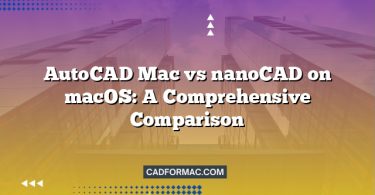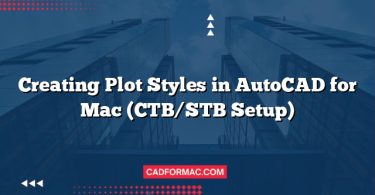For professionals in architecture, engineering, and construction (AEC), choosing the right design software is critical. But for Mac users, the decision becomes more complex due to software compatibility limitations. Autodesk’s flagship tools—AutoCAD and Revit—are industry standards, yet their availability on macOS differs significantly. While AutoCAD has a native macOS version, Revit does not. This leads many Mac users to run Revit through a Windows virtual machine (VM). But which approach is better for your workflow? Let’s break it down.
1. Native Experience: AutoCAD for Mac
Pros:
- Optimized for macOS: AutoCAD for Mac is built specifically for Apple’s operating system, offering a familiar interface that integrates well with macOS features like Dark Mode, Touch Bar support (on compatible models), and native file dialogs.
- Performance: Runs smoothly without the overhead of a virtualization layer. You get direct access to your Mac’s hardware, resulting in faster response times for 2D drafting and basic 3D modeling.
- Stability: Fewer compatibility issues and crashes compared to running software through emulation or virtualization.
- Ease of Use: No need to manage a separate Windows installation or VM software.
Cons:
- Feature Parity: AutoCAD for Mac historically lags behind the Windows version in terms of features and updates. Some advanced tools, customization options (like full .NET API support), and third-party plugins may be missing or limited.
- Collaboration Challenges: If your team primarily uses AutoCAD for Windows, file compatibility is generally good—but subtle differences in linetypes, fonts, or custom objects can occasionally cause hiccups.
2. Running Revit via Virtual Machine on Mac
Since Autodesk does not offer a native macOS version of Revit, Mac users must rely on workarounds. The most common solution is installing Windows via a virtual machine (using Parallels Desktop, VMware Fusion, or Boot Camp).
Pros:
- Full Revit Functionality: You gain access to the complete Revit feature set—including BIM (Building Information Modeling), parametric families, collaboration tools (Worksharing, BIM 360), and advanced rendering—exactly as Windows users experience it.
- Industry Standard: Revit is the de facto BIM platform in AEC. Using it ensures compatibility with consultants, clients, and project standards.
- Plugin Ecosystem: Full support for add-ins like Dynamo, Enscape, and other third-party tools that enhance productivity.
Cons:
- Performance Overhead: Virtual machines introduce latency and reduce hardware efficiency. Revit is resource-intensive, and running it in a VM can lead to slower performance, especially with large models or complex renders.
- Hardware Requirements: You’ll need a Mac with ample RAM (16GB minimum, 32GB recommended), a fast SSD, and a powerful CPU. Apple Silicon (M1/M2/M3) Macs add another layer of complexity—Windows on ARM via Parallels works, but Revit’s x86/x64 architecture requires emulation, which further impacts performance.
- Licensing and Setup: Requires a valid Windows license and a Revit license. Setup and maintenance of the VM environment take time and technical know-how.
- User Experience: Switching between macOS and Windows environments can disrupt workflow. Graphics performance may be suboptimal, and high-DPI display scaling can be inconsistent.
3. Key Considerations for Mac Users
Workflow Needs
- If your work is primarily 2D drafting, detailing, or light 3D modeling, AutoCAD for Mac may suffice and offer a smoother experience.
- If you’re engaged in BIM, structural modeling, MEP coordination, or collaborative design, Revit (even via VM) is likely essential.
Hardware Matters
- Intel-based Macs: Better compatibility with Windows VMs and near-native Revit performance if properly configured.
- Apple Silicon Macs (M1/M2/M3): Windows runs via ARM emulation. While Parallels has made strides, Revit performance remains noticeably slower than on native Windows or Intel Macs with Boot Camp.
Alternative Solutions
- Boot Camp (Intel Macs only): Offers near-native Windows performance by dual-booting, but requires rebooting to switch OS—less convenient than a VM.
- Cloud Workstations: Services like AWS Workspaces or Azure Virtual Desktop can run Revit remotely, streamed to your Mac. This offloads processing but depends on internet stability.
- Cross-Platform BIM Tools: Consider alternatives like Vectorworks (native on Mac) or Graphisoft Archicad, which offer robust BIM capabilities without virtualization.
Verdict: Which Should You Choose?
| Scenario | Recommended Approach |
|---|---|
| 2D drafting, small-scale projects, solo work | AutoCAD for Mac |
| BIM workflows, team collaboration, large projects | Revit via VM (or Boot Camp if on Intel Mac) |
| Using an M1/M2/M3 Mac with limited RAM | AutoCAD for Mac or cloud-based Revit |
| Need full Revit features and have a high-end Intel Mac | Revit via VM or Boot Camp |
Here’s a clear and concise comparison table in Markdown format for the article “AutoCAD Mac vs. Revit via Virtual Machine”
| Feature / Consideration | AutoCAD for Mac (Native) | Revit via Virtual Machine (on Mac) |
|---|---|---|
| Platform Support | Native macOS application | Requires Windows VM (Parallels, VMware, etc.) |
| Performance | Smooth, direct hardware access | Slower due to VM overhead; varies by Mac hardware |
| BIM Capabilities | Limited (primarily 2D/3D drafting) | Full BIM functionality |
| Feature Parity with Windows | Partial—some tools & APIs missing | Full feature set (identical to Windows version) |
| Plugin & Add-in Support | Limited third-party & .NET support | Full support (Dynamo, Enscape, etc.) |
| Hardware Requirements | Moderate (8GB+ RAM, macOS-compatible GPU) | High (16–32GB+ RAM, fast SSD, powerful CPU) |
| Apple Silicon (M1/M2/M3) Compatibility | Fully supported | Runs via Windows ARM emulation (performance hit) |
| Setup Complexity | Simple—install directly from Autodesk | Complex—requires Windows license, VM setup |
| User Experience | Integrated with macOS (Dark Mode, Touch Bar, etc.) | Disconnected from macOS; Windows UI in a window |
| Collaboration & File Exchange | Good for DWG, but minor compatibility issues | Industry standard—seamless team/project alignment |
| Licensing | Single AutoCAD Mac license | Requires Windows + Revit licenses |
| Best For | 2D drafting, detailing, solo/small-scale projects | BIM, architectural design, team-based workflows |
Frequently Asked Questions (FAQ)
1. Can I run Revit natively on an M1/M2/M3 Mac without a virtual machine?
No. Autodesk does not offer a native version of Revit for macOS—on Intel or Apple Silicon Macs. Revit is Windows-only, so even on M-series Macs, you must use a virtual machine (e.g., Parallels with Windows 11 ARM) or remote/cloud solutions.
2. Is AutoCAD for Mac the same as AutoCAD for Windows?
Not exactly. While core drafting tools are similar, AutoCAD for Mac lacks some advanced features found in the Windows version—such as full .NET API support, certain Express Tools, and compatibility with many Windows-only plugins or LISP routines.
3. Does Parallels Desktop support GPU acceleration for Revit on Apple Silicon Macs?
Parallels Desktop does offer GPU acceleration for Windows on ARM, but Revit (an x64 application) runs under emulation on Apple Silicon. This limits hardware acceleration, and Revit’s performance—especially in 3D views or rendering—remains significantly slower than on native Windows hardware.
4. Can I open Revit files (.rvt) in AutoCAD for Mac?
No. AutoCAD cannot natively open or edit Revit (.rvt) files. You can export Revit models to DWG or DXF format for viewing or basic editing in AutoCAD, but all BIM intelligence (parameters, families, relationships) is lost in the process.
5. Is Boot Camp a better option than a VM for running Revit on a Mac?
Boot Camp (dual-booting Windows) offers better performance than a VM—but only on Intel-based Macs. Apple Silicon Macs (M1 and later) do not support Boot Camp at all, making virtualization the only local option for running Windows software.
6. Are there any native macOS BIM alternatives to Revit?
Yes. Graphisoft Archicad and Vectorworks Architect both offer full-featured, native macOS versions with robust BIM capabilities. They may be viable alternatives if your workflow or firm allows switching from Revit.
7. Will my AutoCAD for Mac license work if I install AutoCAD for Windows in a VM?
Generally, no. Autodesk licenses are platform-specific. A Mac subscription typically only authorizes the macOS version. To run AutoCAD for Windows in a VM, you’d need a separate Windows-compatible license (check your subscription details or contact Autodesk support).
8. Can I collaborate on a Revit project if I’m using AutoCAD for Mac?
Only in a limited capacity. You can view or annotate exported 2D drawings (DWG/DXF), but you cannot participate in live BIM collaboration, model coordination, or access Revit’s parametric data. True collaboration requires Revit or a compatible BIM viewer.
Final Thoughts
While AutoCAD for Mac delivers convenience and integration, it doesn’t replace Revit’s BIM capabilities. For Mac users committed to Revit, a virtual machine is a viable—but imperfect—solution. Performance trade-offs are real, especially on Apple Silicon, but often necessary for professional compliance and collaboration.
Before committing, test both setups with your typical project files. Evaluate performance, stability, and workflow disruption. In many cases, the right choice isn’t about which software is “better,” but which aligns best with your projects, team, and hardware.
Note: Autodesk has not announced plans for a native Revit for Mac. Until then, virtualization remains the primary path for Mac-based Revit users.




